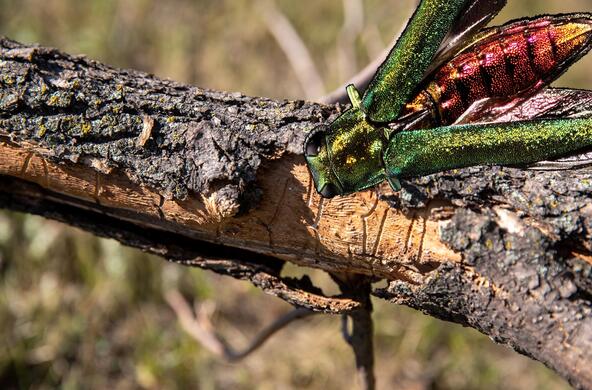As you drive around Dutchess County this fall, try to get a look at the dusky yellows and purples of the ash trees, because they won't be around much longer.
Ashes are among the first trees to change color. Their subtle tones set off the deep red creepers in their branches. Ash trees also are valuable as timber — most famously for baseball bats, but also for flooring and many other uses — and are commonly planted as shade trees.
Ash trees are likely to disappear from Dutchess County and across all of North America as a result of the careless introduction of the emerald ash borer. This Asian insect probably traveled to Detroit in untreated wooden packing materials. Because it went undetected for several years, it was able to establish and spread beyond our control.
Millions of dollars have been spent removing infested trees, treating trees with insecticides, quarantining infested areas, educating people about the dangers of moving firewood and researching biological controls, but it now appears the emerald ash borer will spread across North America and kill nearly all of our ash trees. The nuisance insect has already been seen in seven counties in New York, including Ulster and Greene. Unless a miracle occurs, it will soon appear in Dutchess County.
The ash die-off will affect all of us. Nearly 7 percent of all the trees in New York state are ashes, so there will be a lot of dead trees. The loss of this many trees will affect the character of our forests for years to come and cost us dearly.
For instance, the cost of removing and replacing all of the ash trees planted along streets and in yards has been estimated at $8 billion, money we will all pay for in the form of increased taxes or checks to tree service companies.
Federal and state agencies have been working hard to eradicate the ash borer or slow its spread. Last month, Sen. Charles Schumer was in the Hudson Valley to announce $1.5 million in federal funds to help eradicate the insect.
These well-intentioned but ultimately inadequate measures do not address the real problem: the careless movement of plants and animals around the world. Trying to stop the spread of established pests like the emerald ash borer is like trying to clean up the Gulf oil spill without capping the leaking well.
Careless human activities have already moved thousands of non-native species into the U.S., and dozens more establish themselves each year. Many of these species cause ecological and economic harm.
As long as we keep waiting until an invader has gotten out of control and causes huge damage, then defining the issue as "the ash borer problem," "the silver carp problem" or "the mile-a-minute vine problem," we are always going to be playing catch-up and will have few good options for solving these "problems." We need to start thinking about the next pest, not the last one.
And the emerald ash borer is just the latest in a long list of invasive forest pests and diseases that have wreaked havoc with our trees — chestnut blight, Dutch elm disease, hemlock woolly adelgid, and Asian longhorned beetle, among others — and have caused tens of billions of dollars in damage. Many of these forest pests reach us on live plants imported for the horticultural trade or as unintentional stowaways in untreated wood packing material, such as crates and pallets.
Both of these routes of entry should be shut off.
First, we should ban the importation of live plants altogether. The horticultural trade will howl at this suggestion, but it reaps all the profit from this trade while U.S. citizens pay the steep price of economic and ecological damage.
Second, we need effective enforcement of existing laws requiring wood packing material to be treated at its point of origin to kill insects such as the emerald ash borer. This would involve greatly beefed-up inspections at our ports and serious penalties for infractions.
Third, we need to develop better networks for the early detection and rapid eradication of invaders.
All of these steps could have prevented the ash disaster, and can prevent future disasters.
Think about this when you're taking a last look at the ashes this fall, or writing a check to replace the dying shade tree in your yard. And if you're sad or angry or disappointed with our inability to wisely manage the beautiful world we've been given, share your feelings with your elected officials.






